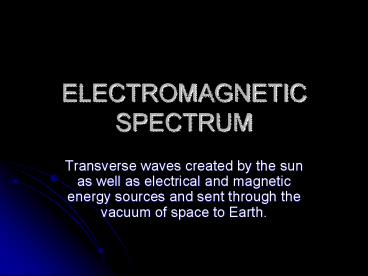ELECTROMAGNETIC SPECTRUM - PowerPoint PPT Presentation
1 / 13
Title:
ELECTROMAGNETIC SPECTRUM
Description:
ELECTROMAGNETIC SPECTRUM Transverse waves created by the sun as well as electrical and magnetic energy sources and sent through the vacuum of space to Earth. – PowerPoint PPT presentation
Number of Views:85
Avg rating:3.0/5.0
Title: ELECTROMAGNETIC SPECTRUM
1
ELECTROMAGNETIC SPECTRUM
- Transverse waves created by the sun as well as
electrical and magnetic energy sources and sent
through the vacuum of space to Earth.
2
EM Spectrum Diagram
- Diagram
3
Measuring the electromagnetic spectrum
- You actually know more about it than you may
think! - The electromagnetic (EM) spectrum is just a name
that scientists give a bunch of types of
radiation when they want to talk about them as a
group. - Radiation is energy that travels and spreads out
as it goes-- visible light that comes from a lamp
in your house or radio waves that come from a
radio station are two types of electromagnetic
radiation. - Other examples of EM radiation are microwaves,
infrared and ultraviolet light, X-rays and
gamma-rays. - Hotter, more energetic objects and events create
higher energy radiation than cool objects. - Only extremely hot objects or particles moving
at very high velocities can create high-energy
radiation like X-rays and gamma-rays.
4
EM Spectrum
- Here are the different types of radiation in the
EM spectrum, in order from lowest energy to
highest - Radio yes, this is the same kind of energy that
radio stations emit into the air for your boom
box to capture and turn into your favorite
Mozart, Madonna, or Coolio tunes. But radio waves
are also emitted by other things ... such as
stars and gases in space. You may not be able to
dance to what these objects emit, but you can use
it to learn what they are made of.
5
EM Spectrum
- Microwaves they will cook your popcorn in just a
few minutes! In space, microwaves are used by
astronomers to learn about the structure of
nearby galaxies, including our own Milky Way!
6
EM Spectrum
- Infrared we often think of this as being the
same thing as 'heat', because it makes our skin
feel warm. In space, IR light maps the dust
between stars.
7
EM Spectrum
- Visible yes, this is the part that our eyes see.
Visible radiation is emitted by everything from
fireflies to light bulbs to stars ... also by
fast-moving particles hitting other particles.
8
EM Spectrum
- Ultraviolet we know that the Sun is a source of
ultraviolet (or UV) radiation, because it is the
UV rays that cause our skin to burn! Stars and
other "hot" objects in space emit UV radiation.
9
EM Spectrum
- X-rays your doctor uses them to look at your
bones and your dentist to look at your teeth. Hot
gases in the Universe also emit X-rays .
10
EM Spectrum
- Gamma-rays radioactive materials (some natural
and others made by man in things like nuclear
power plants) can emit gamma-rays. Big particle
accelerators that scientists use to help them
understand what matter is made of can sometimes
generate gamma-rays. But the biggest gamma-ray
generator of all is the Universe! It makes gamma
radiation in all kinds of ways.
11
EM Spectrum
- We may think that radio waves are completely
different physical objects or events than
gamma-rays. They are produced in very different
ways, and we detect them in different ways. But
are they really different things? The answer is
'no'. Radio waves, visible light, X-rays, and all
the other parts of the electromagnetic spectrum
are fundamentally the same thing. They are all
electromagnetic radiation.
12
EM Spectrum
- Actually, the electromagnetic spectrum can be
expressed in terms of energy, wavelength, or
frequency. Each way of thinking about the EM
spectrum is related to the others in a precise
mathematical way. So why do we have three ways of
describing things, each with a different set of
physical units? After all, frequency is measured
in cycles per second (which is called a Hertz),
wavelength is measured in meters, and energy is
measured in electron volts.
13
EM Spectrum
- Electromagnetic radiation from space is unable to
reach the surface of the Earth except at a very
few wavelengths, such as the visible spectrum,
radio frequencies, and some ultraviolet
wavelengths. Astronomers can get above enough of
the Earth's atmosphere to observe at some
infrared wavelengths from mountain tops or by
flying their telescopes in an aircraft































